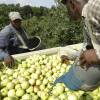Ahead of Hurricane Ian making landfall in Florida as a Category 4 storm , we asked meteorologist and horticulturalist Dave Epstein to explain how the hurricane will impact Florida’s Gulf Coast and whether New Englanders should be thinking about hurricane season. This transcript has been lightly edited.
Have a gardening or weather question for meteorologist Dave Epstein? Tweet him @GrowingWisdom , email us at thewakeup@wgbh.org , or text 617-300-2008.
What should Floridians expect from Hurricane Ian?
Hurricane Ian came ashore at high tide as a Category 4 storm. Landfall coincided with high tide, which is concerning for storm surges — the water that rushes in with the storm, temporarily bringing the ocean onto what is usually dry land.
“If you think about our own area, if we had a hurricane come onshore during high or low tide, it makes a huge difference,” Epstein said. “Our tides are bigger than they are down there. But nevertheless, a 2- to 3-foot change makes a huge difference in the damage they're going to see where that storm does come onshore.”
More Local News
What is a hurricane?
Think of it as a collection of rotating thunderstorms with especially strong winds, Epstein said. To qualify as a hurricane, the storm must have sustained winds blowing at 74 miles an hour or more. Ian approached Florida with maximum sustained winds at 155 miles an hour — a Category 4 storm, which can leave extreme damage.
How does one track a hurricane?
When Epstein was a child, his grandmother lived in Palm Beach, Florida, and would send him the hurricane tracking maps printed on her grocery bags. They were blank maps with latitude and longitude lines, and people could use them to mark the coordinates of hurricanes and track their movements.
Now, Epstein said, the National Hurricane Center’s meteorologists will post their work online so anyone with an internet connection can track the storm.
“Now, in terms of where it's going to go, that's done with computer models,” Epstein said. “It's the same models in some extent that we used to track nor'easters and all our other weather. But there are also … models specifically built to track the differences of hurricanes.”
What kind of damage might people see?
It falls into three categories, Epstein said. As the eye of the storm approaches, people will see heavy rain that can cause freshwater flooding. “If you live in a low-lying area that gets flooded, your first floor could get freshwater. And it's similar to what we would see here if we had freshwater flooding,” Epstein said.
As the eye of the storm goes over Florida, people in its path will see dangerous winds. In this case, people within a 35-mile radius of the eye will feel the strongest winds, though tropical storm–force winds will affect a much wider area.
“That's going to be located in a fairly narrow area as the storm crosses on shore, with those incredibly strong winds,” Epstein said. “A Category 4 takes roofs off. It will not remove, generally, a well-built home.”
After the eye passes, people should keep sheltering where they are or call rescue authorities if they cannot stay in place safely. The storm surge — essentially a dangerously high tide of ocean water rushing into land — is expected.
“That’s where you can see really bad damage because that wall of water, anywhere from 6 to 12 feet of water, depending on where exactly you are, that comes in and that does a tremendous amount of damage,” Epstein said.
How often do hurricanes hit southern New England?
They’re rare, and typically much weaker than the ones that hit the Caribbean, Gulf states and the Southeastern United States, but they do happen.
Epstein’s advice: There’s no need to panic. It may be a good idea to look at big old trees in your neighborhood, especially if they are near power lines that could be damaged in a storm.
“We have not had a hurricane here since Bob, in 1991,” Epstein said. “That's the last official hurricane to reach New England shores. We're well overdue if you look statistically at when hurricane hit. Generally, it was much more frequent prior to that.”










